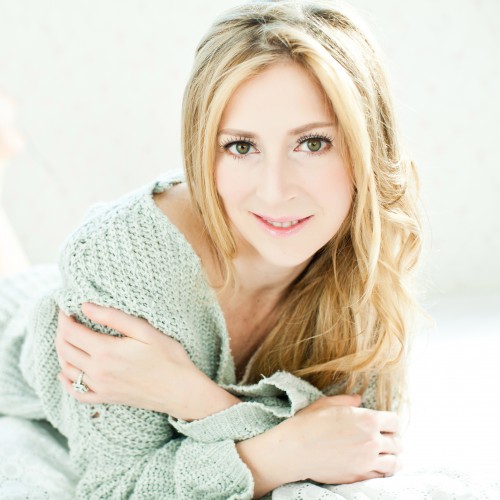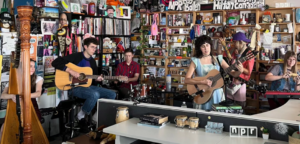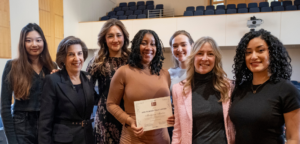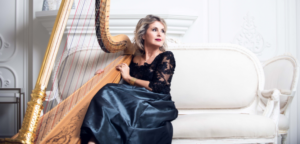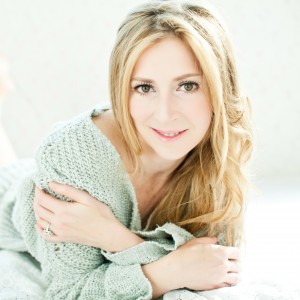
Philadelphia Orchestra harpist Elizabeth Hainen recently released her newest album, Home. With the holidays nearing and harpists around the world traveling to celebrate the festivities with their loved ones, we spoke with Hainen about her recent experiences recording pieces that she loves to play in the comfort of her home and picked her brain about what it’s like to make music with family members.
Home is your fifth solo album—can you tell us what inspired this latest recording?
A couple of winters ago, I endured multiple snowstorms in the sanctuary of my Victorian row home. Philadelphia was shut down each time, but fortunately I had electricity, groceries, wine, and my harp. For a performing musician, there is always a concert deadline so it’s rare to have the opportunity to practice for one’s self. I took advantage of my mini sabbatical by playing some of my favorite diminutive works with my Parsons Russell Terrier, Cosmo, at my side. While enjoying this rare indulgence, it occurred to me that many memorable musical encounters have taken place in our home often as salon concerts with my husband, David DePeters. This inspired me to record all the pieces I like to play for myself at home. I guess you could say, “Home is where your harp is!”
This album has an amazing mix of composers, from Handel to Debussy to Phillip Glass to Sting! How do you approach such different styles of music?
To me, the genesis of this program starts with Bach. Well-balanced tone control and fine articulation is imperative when playing Bach and assists us on the harp in every musical dimension. Everything for me begins with Bach. The minimalistic writing of Glass definitely takes its cue from some of the preludes in the Well-Tempered Clavier and Sting also loved studying [him].
I could listen to “Metamorphosis” by Phillip Glass all day long. Do you have a favorite track on the record?
I also enjoy the Philip Glass! Incidentally, what really helped me with this piece and the hypnotic, yet fatiguing, passagework was my yoga practice. In yoga, we strive to stay in the moment by following our breath and isolate physical and mental movement. It’s kind of like standing on your head for 10 minutes and using efficient and spare effort. My favorite piece is “Les Barricades Mystérieuses” by Couperin—the title alone evokes a sense of an unsolved riddle. There is no proven definition in regards to the title, but “barricades” and the musical suspensions throughout the score might refer to a double-meaning (double entendres), which might suggest sexual undertones regarding a woman’s chastity or even an unmentionable article of clothing. This doesn’t come into my interpretation, only the perfection in counterpoint and beautiful harmonies.
You collaborate with your husband, percussionist David DePeters, on a few of the tracks. What is it like to play music and record together?
If we can only find time to practice! Throughout our relationship, we have rarely lived in one house or one state. Now he is the executive director of the National Repertory Orchestra and spends most of his time in Breckenridge, Colorado. We certainly enjoy performing together, much more than practicing. I will refrain from saying anything further.
Any exciting upcoming projects on the horizon that you can share with Harp Column readers?
Yes! As if it weren’t enough that Tan Dun wrote this incredible piece for harp and the Philadelphia Orchestra, now we just finished the world premiere audio and video recording with Music Director Yannick Nézet-Séguin. If you haven’t heard Nu Shu: Secret Songs of Women, it is truly the most exciting piece featuring the harp since the Ginastera Harp Concerto. It’s not a concerto, but more of a dramatic symphony with the harp as storyteller. We accompany the last surviving Nu Shu practitioners that Tan filmed in their native village. They are singing stories that describe everything from sister secrets to a young girl’s ritual of crying into a wedding tapestry that must be filled with tears before her marriage takes place. I believe the premiere will be broadcast on television so stay tuned!
Clearly you stay extremely busy between premiering works, putting out albums, playing with the Philadelphia Orchestra, teaching at Curtis Institute of Music and Temple University, and developing your non-profit Lyra Society. When you aren’t making music, how do you spend your time?
If I’m not creating, then I’m bored. So, yes, it probably looks like I’m always up to something. I’m about to unveil a new degree program and revamped harp department at Boyer College of Music at Temple University that will include an international team of harpists. Aside from the harp, I am a yoga enthusiast and spend as much time biking, hiking, and skiing in the mountains.
For more information on Elizabeth Hainen, visit www.elizabethhainen.com. Home is available on iTunes and Amazon.






